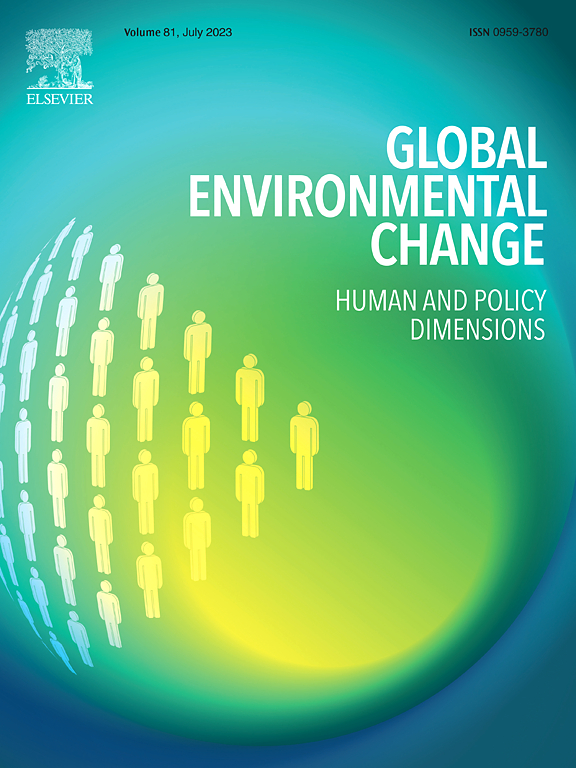De-energization as maladaptation: Uneven residential exposure to wildfire Public Safety Power Shutoffs and compound heat
IF 9.1
1区 环境科学与生态学
Q1 ENVIRONMENTAL SCIENCES
引用次数: 0
Abstract
In response to growing levels of wildfire destruction, electric utility companies are adopting powerline de-energization as an adaptation strategy intended to prevent wildfire ignitions. While reducing wildfire risk, planned de-energizations also expose residents to electricity loss, potentially causing harmful consequences. We investigated the extent to which planned de-energization can be considered a form of maladaptation, in which an adaptive response to a climate-related hazard results in unintended, concurrent harms. To do so, we examined the co-occurrence of Public Safety Power Shutoffs (PSPSs) with extreme heat (temperature ≥ 32 °C) in California between October 2021 and September 2024. Our analysis revealed compound heat-PSPS outages throughout this period, including extreme temperatures exceeding 40 °C, during power shutoffs. Compound heat-PSPS events were geographically concentrated in census block groups with higher proportions of older adults and mobile home residents, both populations which may be at increased risk of heat-related morbidity and mortality. While they affected a relatively small proportion of customers de-energized by PSPSs, compound heat-PSPS outages raise concerns over extreme heat exposure when access to electricity-based cooling strategies is curtailed. Evaluating the maladaptive effects of institutional responses to climate change hazards is critical for comprehensively weighing both the benefits and harms of emerging adaptation strategies.
作为不适应的断电:不均匀的住宅暴露于野火公共安全断电和复合热
为了应对日益严重的野火破坏,电力公司正在采用输电线断电作为一种适应策略,旨在防止野火点燃。在减少野火风险的同时,计划中的断电也使居民面临电力损失,可能造成有害后果。我们调查了计划性断电在多大程度上可以被认为是一种适应不良的形式,在这种情况下,对气候相关危害的适应性反应会导致意想不到的、同时发生的危害。为此,我们研究了2021年10月至2024年9月期间加州极端高温(温度≥32°C)下公共安全停电(psp)的共同发生情况。我们的分析显示,在停电期间,复合热- psps中断,包括超过40°C的极端温度。复合热- psps事件在地理上集中在老年人和活动房屋居民比例较高的人口普查街区群体中,这两个人群可能面临与热相关的发病率和死亡率增加的风险。虽然它们影响了相对较小比例的被psps断电的客户,但复合热- psps停电引起了人们对极端高温暴露的担忧,因为电力冷却策略的使用受到限制。评估机构应对气候变化危害的不良影响对于全面权衡新出现的适应战略的利弊至关重要。
本文章由计算机程序翻译,如有差异,请以英文原文为准。
求助全文
约1分钟内获得全文
求助全文
来源期刊

Global Environmental Change
环境科学-环境科学
CiteScore
18.20
自引率
2.20%
发文量
146
审稿时长
12 months
期刊介绍:
Global Environmental Change is a prestigious international journal that publishes articles of high quality, both theoretically and empirically rigorous. The journal aims to contribute to the understanding of global environmental change from the perspectives of human and policy dimensions. Specifically, it considers global environmental change as the result of processes occurring at the local level, but with wide-ranging impacts on various spatial, temporal, and socio-political scales.
In terms of content, the journal seeks articles with a strong social science component. This includes research that examines the societal drivers and consequences of environmental change, as well as social and policy processes that aim to address these challenges. While the journal covers a broad range of topics, including biodiversity and ecosystem services, climate, coasts, food systems, land use and land cover, oceans, urban areas, and water resources, it also welcomes contributions that investigate the drivers, consequences, and management of other areas affected by environmental change.
Overall, Global Environmental Change encourages research that deepens our understanding of the complex interactions between human activities and the environment, with the goal of informing policy and decision-making.
 求助内容:
求助内容: 应助结果提醒方式:
应助结果提醒方式:


